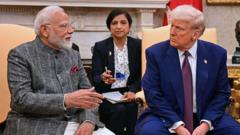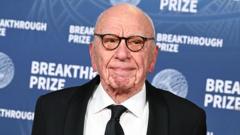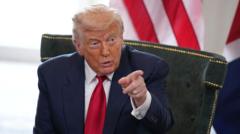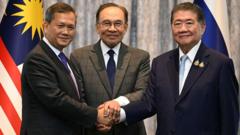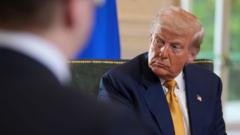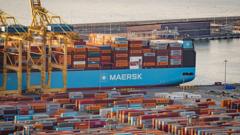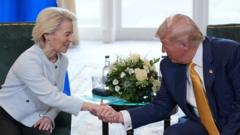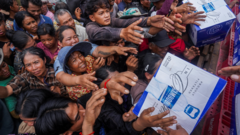US Vice-President JD Vance’s arrival in New Delhi marks a significant moment in US-India trade relations, with discussions anticipated to tackle mounting tariff tensions.
Vance Meets Modi in Delhi Amid Ongoing Trade Disputes

Vance Meets Modi in Delhi Amid Ongoing Trade Disputes
US Vice-President JD Vance embarks on crucial talks in India to address tariff tensions and strengthen bilateral relations.
In a visit that underscores ongoing trade disputes, US Vice-President JD Vance has landed in the Indian capital, ready to engage in vital discussions with Prime Minister Narendra Modi. The four-day tour emphasizes efforts to expedite a long-awaited bilateral trade agreement, framed against the backdrop of escalating trade tensions derived from US tariff policies.
Vance's itinerary includes family outings to iconic sites in Agra and Jaipur, enhancing the personal dimension of this diplomatic visit. His trip emerges especially pertinent as countries worldwide scramble to secure trade agreements in light of US President Donald Trump’s scheduled 90-day tariff pause, which is set to expire on July 9. "The two nations will also deliberate on regional and global matters of common concern," indicated the Indian foreign ministry ahead of Vance's talks.
Accompanied by his wife, Usha Vance—whose parents immigrated from Andhra Pradesh—and their children, Vance began his New Delhi visit with a tour of the famous Akshardham temple. The day’s agenda is capped with a formal meeting and dinner hosted by Modi, aiming to fortify ties amid turbulent trade dynamics.
This visit coincides with heightened friction in international trade relations, particularly following Trump's announcement of extensive reciprocal tariffs. Previously, the president labeled India a "tariff abuser," which catalyzed his introduction of a 27% tariff on Indian imports before the current temporary reprieve instituted on April 9.
In a bid to ease tensions, India has reduced tariffs on several US products, though further adjustments are anticipated, considering the substantial $45 billion trade surplus India holds. Comparatively, India's average tariffs hover around 12%, eclipsing the US's 2%. Historically, the US has been India’s largest trading partner, with bilateral trade figures soaring to $190 billion (£144 billion).
The relationship has been characterized by strong engagements; Modi was among the first leaders to meet Trump post-inauguration, marking their partnership as "mega." Both leaders previously targeted a goal of raising trade volume to $500 billion, emphasizing US exports to India that include oil and gas.
Following Vance’s diplomatic maneuvers, anticipation is also building for Trump’s visit planned for later this year to attend the Quad summit, alongside leaders from Australia and Japan. India's foreign ministry spokesperson Randhir Jaiswal expressed optimism regarding Vance's participation, suggesting it may reinvigorate bilateral connections further.
For more updates, follow us on Instagram, YouTube, X, and Facebook.
Vance's itinerary includes family outings to iconic sites in Agra and Jaipur, enhancing the personal dimension of this diplomatic visit. His trip emerges especially pertinent as countries worldwide scramble to secure trade agreements in light of US President Donald Trump’s scheduled 90-day tariff pause, which is set to expire on July 9. "The two nations will also deliberate on regional and global matters of common concern," indicated the Indian foreign ministry ahead of Vance's talks.
Accompanied by his wife, Usha Vance—whose parents immigrated from Andhra Pradesh—and their children, Vance began his New Delhi visit with a tour of the famous Akshardham temple. The day’s agenda is capped with a formal meeting and dinner hosted by Modi, aiming to fortify ties amid turbulent trade dynamics.
This visit coincides with heightened friction in international trade relations, particularly following Trump's announcement of extensive reciprocal tariffs. Previously, the president labeled India a "tariff abuser," which catalyzed his introduction of a 27% tariff on Indian imports before the current temporary reprieve instituted on April 9.
In a bid to ease tensions, India has reduced tariffs on several US products, though further adjustments are anticipated, considering the substantial $45 billion trade surplus India holds. Comparatively, India's average tariffs hover around 12%, eclipsing the US's 2%. Historically, the US has been India’s largest trading partner, with bilateral trade figures soaring to $190 billion (£144 billion).
The relationship has been characterized by strong engagements; Modi was among the first leaders to meet Trump post-inauguration, marking their partnership as "mega." Both leaders previously targeted a goal of raising trade volume to $500 billion, emphasizing US exports to India that include oil and gas.
Following Vance’s diplomatic maneuvers, anticipation is also building for Trump’s visit planned for later this year to attend the Quad summit, alongside leaders from Australia and Japan. India's foreign ministry spokesperson Randhir Jaiswal expressed optimism regarding Vance's participation, suggesting it may reinvigorate bilateral connections further.
For more updates, follow us on Instagram, YouTube, X, and Facebook.






